语言学教程第一章ppt
- 格式:dps
- 大小:159.50 KB
- 文档页数:36
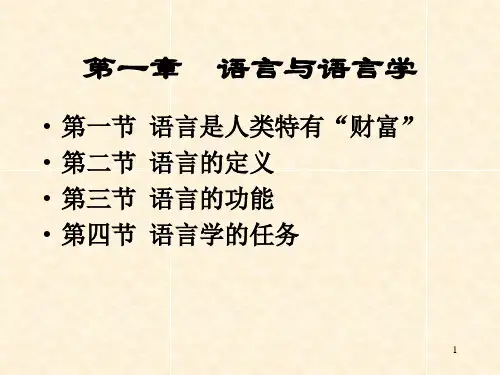
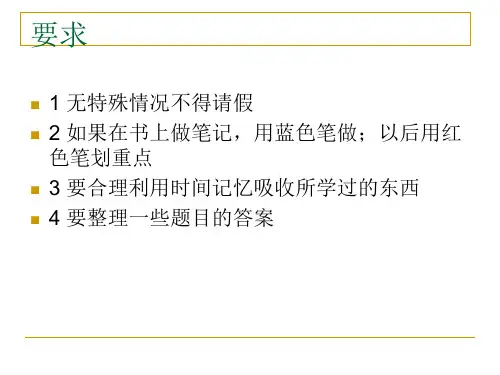

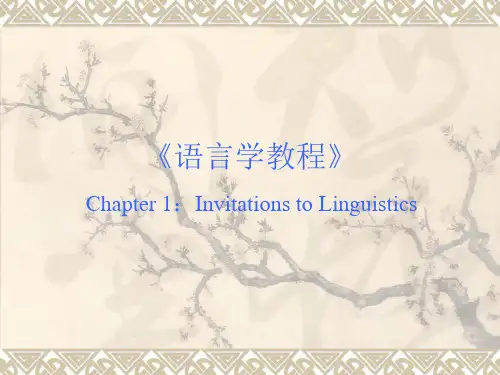

Linguistics●Why study linguistics?Linguistics is the scientific study of language. (Lyons,1968).the process of linguistic study1st : O bserving & questioning2nd: Formulating hypotheses3rd: Verifying the hypotheses4th: Proposing a theoryFour principles in linguistics study:●exhaustiveness●consistency●economy●objectivity(大连外语考研)●Language and LinguisticsLinguistics:a brilliant and fascinating exploration of the basic weapon by which man has advanced from savagery to civilization.-----Mario Pei马里奥·佩●“We sometimes overlook the fact that th ere is much that we can knowand need to know about our universe and ourselves. By the same token, we are too prone to reject knowledge for which we cannot find an immediate practical application.”Chapter 1When we study human language, we are approaching what some might call the “human essence”, the distinctive qualities of mind that are, so far as we know, unique to man. (Noam Chomsky, 1972, Language and Mind)●乔姆斯基(Noam Chomsky, 1928--)●“Chomsky is currently among the most-cited writers in all of the humanities(behind only Marx, Lenin, Shakespeare, Aristotle, Plato, and Freud) and the only living number of the top ten.” (Pinker,1994)● 1. What is Language?●Definitions of Language:Language is a system of arbitrary vocal symbols used for human communication.Key words:Language as systemSound <Phonetics发音学< Phonology 音韵学Structure <morphology 形态学<Syntax 句法学meaning <Semantics语义学<Pragmatics 语用学●Definitions of Language:●Language is a means of verbal communication.It is instrumental; it is social and conventional.(P3)2.Origin of language●The …Divine‟ origin:●The “bow-wow” theory “汪汪理论”●Imitation of the sounds of the animal●OnomatopoeicProblematic (P9)●The “pooh-pooh” theory噗噗理论●instinctive sounds of pain, anger and joy.●interjections●Problematic (P9)●The “yo-he-ho” theory“哟-嗬-哟理论”rhythmic grunts●Problematic (P9)● 3. Design Features of Language●Design features (本质特征) refer to the defining properties of human languagethat distinguish it from any animal system of communication. (P4)●Language distinguishes human beings from animals in that it is far moresophisticated than any animal communication system.● 2.Design features2.1 Arbitrariness2.2 Duality2.3 Creativity2.4 Displacement● 1. Arbitrariness●--Ferdinand de Saussure 索绪尔(Swiss)●the forms of linguistic signs bear no natural (logical, intrinsic)relationship to their meaning●At lexical level:词汇层面“A rose by any other name would smell as sweet.”---Shakespeare in Romeo and JulietCan onomatopoeia change the arbitrary nature of language?●at the syntactic level●language is not arbitrary at the syntactic level.●(a) He came in and sat down.●(b) He sat down and came in.●(c) He sat down after he came in.Arbitrariness and convention●Duality(双重性)●Duality means that language has two levels of structure, the primary leveland the secondary level.●At secondary level are elements which have no meaning but which combine toform units at primary level which do have meaning.●Secondary level is made up of meaningless sounds, and primary level ofmeaningful words.●Does the traffic light system have duality?Creativity (创造性)Recursiveness (递归性)means that one sentence can expand into endless possible sentences in a way of recurring.Displacement (移位性)●Displacement enables us to talk about a wide range of things.Unlike animal communication systems, human language is ()(电子科大2003考研)(p8)A.Stimulus freeB.Stimulus boundC.Under immediate stimulus controlD.Stimulated by some occurrence of communal interest4. Functions of language1 Informative(信息功能)2 Interpersonal function(人际功能)It embodies the use of language to express, establish and maintain social relations. The ways you talk to different people show your social status.3 Performativ e (施为功能)It means that language is also used to “do things”, to perform actions.It is primarily to change the social status of a person, or the state of a thing.4 Emotive function(感情功能)It is the use of language to reveal some feelings and attitudes of the speaker.5 Phatic communion (寒暄功能)It refers to language used for maintaining social contact rather than exchanging information or ideas.6 Recreational function (娱乐功能)It refers to the use of language for the sheer joy of using it.7. Metalingual function (元语言功能)The metalingual function is used to clarify meanings or what the other personhas said.5. Important Distinctions1 Descriptive vs. prescriptive2 Synchronic vs. diachronic3 Langue vs. parole4 Competence vs. performance1 Descriptive vs. Prescriptive (描写式和规定式)A linguistic study is descriptive if it describes and analyses facts observed; it is prescriptive if it tries to lay down rules for correct behavior.The description of a language at any one time is a synchronic study; the description of a language as it changes through time is a diachronic study.__________ studies a particular state of language;__________ studies the historical development of a language.Parole refers to the realization of langue._______: abstract_______: specific_______: stable and systematic_______: subject to personal and situational constraintsAs a social product, langue is a set of conventions that members of a speech community seem to abide by. Parole, on the other hand, is the concrete use of the conventions.Competence is the language user’s intuitive knowledge of his language.Performance is the actual realization of this knowledge in utterances.A speaker’s competence is s_____, but his performance is often influenced by p___________ factors.Where does the knowledge of language come from?Chomsky’s solution is to invoke the innate properties of the mind.What is the difference between these two pairs of distinction?Similarity:Difference:Saussure looks at language from a ___________ point of view;Chomsky looks at it more from a _____________ point of view.According to Saussure and Chomsky, which should be studied, the abstract knowledge or the actual speech?The significance of these two distinctions lies in defining the task of linguistics, which is to discover langue from instances of parole, to discover the language knowledge of the speaker from his performances.。
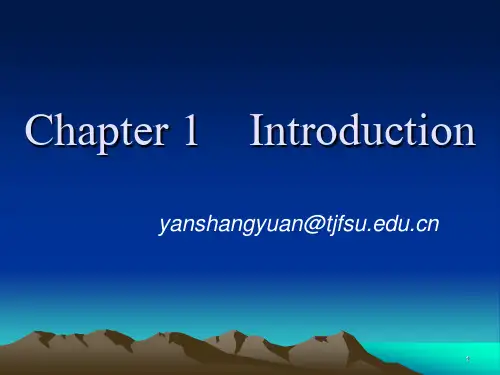
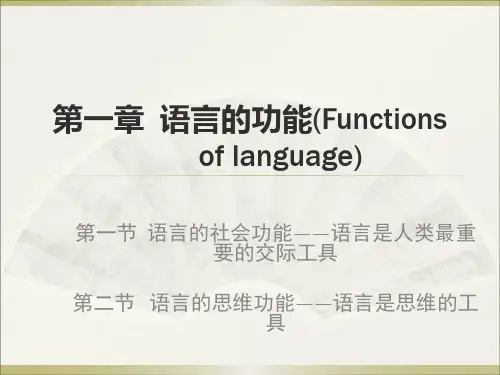


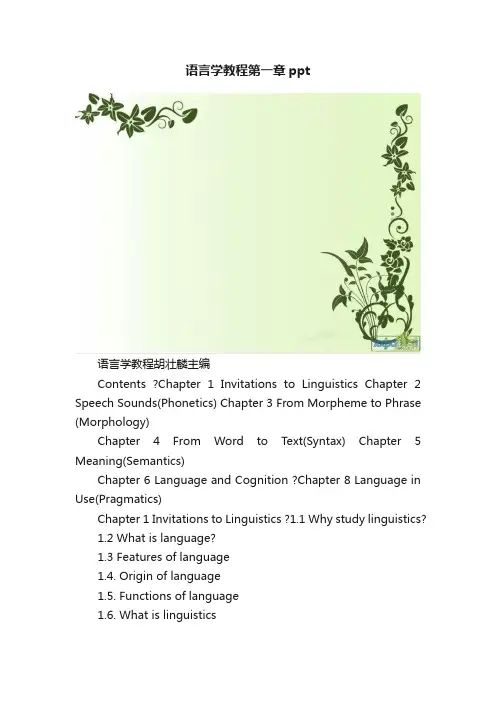
语言学教程第一章ppt语言学教程胡壮麟主编Contents ?Chapter 1 Invitations to Linguistics Chapter 2 Speech Sounds(Phonetics) Chapter 3 From Morpheme to Phrase (Morphology)Chapter 4 From Word to Text(Syntax) Chapter 5 Meaning(Semantics)Chapter 6 Language and Cognition ?Chapter 8 Language in Use(Pragmatics)Chapter 1 Invitations to Linguistics ?1.1 Why study linguistics?1.2 What is language?1.3 Features of language1.4. Origin of language1.5. Functions of language1.6. What is linguistics1.7 Main branches of linguistics1.8. Macrolinguistics1.9 Important distinctions in linguisticsLead-inQestion1: Other animals can beat us in many different ways, but what makes us superior to all of them?Qestion2: Why are children easy to undrstand their mother's tongue??Qestion3: Why do people in different social classes speak in different ways??Qestion4: Why is it "I love you" in English, but "私はあなたを愛して" in Japanese?1.2 What is language ?Language is a system of arbitrary vocal symbols used for human communication.__ by (英)沃德霍(Wardhaugh,R.)1.3 Design Features of languageArbitrarinessDualityCreativityDisplacement1.3.1 Arbitrariness ?Arbitrariness: the forms of linguistic signs bear no natural relationship to their meaning –Saussure.Eg: name,book,pen(1) Arbitrary relationship between the sound of a morpheme and its meaning.Eg: Hi, Aha,Hush, Hem, Hey.(2) Arbitrariness at the syntactic level: according to systemic-functionalists and American functionalists, language is not arbitrary at the syntactic level. In other words, syntax is less arbitrary than words.Eg: He came in and sat down.(3) Idiom is not arbitrary.Eg: apple-polisher, black sheep, a yellow dog.1.3.2 DualityDuality (double articulation)Lower level----sounds (meaningless Eg: Consonants and Vowels)Higher level----meaning (larger units of meaning Eg: word)A communication system with duality is considered more flexible than one without it, for a far greater number of messages can be sent.A small number of sounds can be grouped and regrouped into a large number of units of meaning (words), and the units of meaning can be arranged and rearranged into an infinite number of sentences. (we make dictionary of a1.3.3 CreativityPeculiar to human languages,users of language can understand and produce sentences they have never heard before, e.g. we can understand sentence like “A red-eyed elephant is dancing on the hotel bed”, though it does not describe a common happening in the world.Eg: 说曹操曹操到(not refer to Cao Cao himself)1.3.4 Displacement----Language can be used to refer to things, which are not present: real or imagined matters, in the past, present or future, or in far-away places.Eg: 911 events , New York1.4. Origin of language语言的起源是语言学的基本理论问题之一。
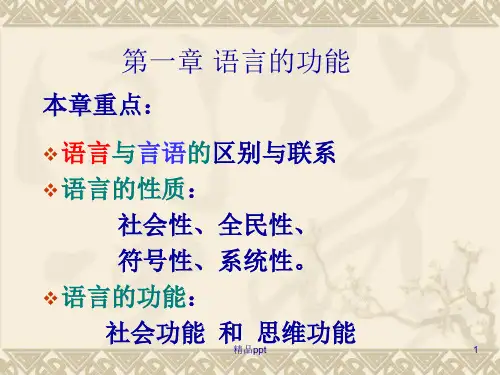
Linguistics: A Course Book 语言学教程胡壮麟主编Contents •Chapter 1 Invitations to Linguistics Chapter 2 Speech Sounds(Phonetics) Chapter 3 From Morpheme to Phrase (Morphology)Chapter 4 From Word to Text(Syntax) Chapter 5 Meaning(Semantics)Chapter 6 Language and Cognition •Chapter 8 Language in Use(Pragmatics)Chapter 1 Invitations to Linguistics •1.1 Why study linguistics?•1.2 What is language?•1.3 Features of language•1.4. Origin of language•1.5. Functions of language•1.6. What is linguistics•1.7 Main branches of linguistics•1.8. Macrolinguistics•1.9 Important distinctions in linguisticsLead-in•Qestion1: Other animals can beat us in many different ways, but what makes us superior to all of them?•Qestion2: Why are children easy to undrstand their mother's tongue?•Qestion3: Why do people in different social classes speak in different ways?•Qestion4: Why is it "I love you" in English, but "私はあなたを愛して" in Japanese?1.2 What is language •Language is a system of arbitrary vocal symbols used for human communication.__ by (英)沃德霍(Wardhaugh,R.)1.3 Design Features of language•Arbitrariness•Duality•Creativity•Displacement1.3.1 Arbitrariness •Arbitrariness: the forms of linguistic signs bear no natural relationship to their meaning –Saussure.Eg: name,book,pen•(1) Arbitrary relationship between the sound of a morpheme and its meaning.•Eg: Hi, Aha,Hush, Hem, Hey.•(2) Arbitrariness at the syntactic level: according to systemic-functionalists and American functionalists, language is not arbitrary at the syntactic level. In other words, syntax is less arbitrary than words.•Eg: He came in and sat down.•(3) Idiom is not arbitrary.•Eg: apple-polisher, black sheep, a yellow dog.1.3.2 Duality•Duality (double articulation)•Lower level----sounds (meaningless Eg: Consonants and Vowels)•Higher level----meaning (larger units of meaning Eg: word)•A communication system with duality is considered more flexible than one without it, for a far greater number of messages can be sent.A small number of sounds can be grouped and regrouped into a large number of units of meaning (words), and the units of meaning can be arranged and rearranged into an infinite number of sentences. (we make dictionary of a1.3.3 Creativity•Peculiar to human languages,users of language can understand and produce sentences they have never heard before, e.g. we can understand sentence like “A red-eyed elephant is dancing on the hotel bed”, though it does not describe a common happening in the world.•Eg: 说曹操曹操到(not refer to Cao Cao himself)1.3.4 Displacement•----Language can be used to refer to things, which are not present: real or imagined matters, in the past, present or future, or in far-away places.•Eg: 911 events , New York1.4. Origin of language•语言的起源是语言学的基本理论问题之一。
对于语言的起源问题。
有摹声说"bow-wow"、“pooh-pooh”theory、劳动号子yo-he-ho说、“社会契约”论和“手势语言”论。
•语言的发展必然包含两个方面:语言交际功能的发展和语言结构系统的发展。
•消亡的词汇不少,但是新产生的更多。
词汇变化的另一形式表现为词意的改变。
词汇在不同的历史时期可以具有不同的词义,•语音的变化虽然不如词汇明显,但是它也是随着时间的推移在发展的。
英语历史上就出现了“元音大变迁”。
•语法也同样在发生变化。
1.4. Origin of language•第一种文字图画文字。
•第二种文字是表意文字。
表意文字是名副其实的文字,具有文字所必需的特征。
•历史上著名的表意文字有四种:古埃及文字、巴比伦楔形文字、中美洲的玛雅文字和我国的汉字。
表意文字是有原始的表形文字演变而来的。
•第三种文字是类型是表音文字。
根据书面符号所代表的语音单位,表音文字又可以分为音节文字、辅音文字和音素文字。
•表音文字中用于拼写词语读音的基本书写单位叫做字母。
•使用表音文字的语言的全部基本字母按一定顺序排列起来就构成语言的字母表。
拉丁字母表与斯拉夫字母表以及阿拉伯字母表一起是世界上通行1.5 Functions of language •Jakobson:referential;poetic;emotive;conative(意动的);phatic(交感的);metalingual function •Halliday : ideational; interpersonal; textual •Informative•Interpersonal•Performative•Emotive•Phatic communion•Recreational•Metalingual1.5.1 Informative •Language is the instrument of thought and people often feel need to speak their thoughts aloud, for instance, when they are working on a math problem.1.5.3 Performative•(1) This concept originates from the philosophical study of language represented by Austin and Searle.•(2) The performative function of language is primarily to change the social status of persons, as in marriage ceremonies, the sentencing of criminals, the blessing of children, the naming of a ship at a launching ceremony, and the cursing of enemies.•Eg: Kill him!•Fire!1.5.2 Interpersonal Function •Interpersonal function, by which people establish and maintain their status in a society.1.5.4 Emotive Function •The emotive function of language is one of the most powerful uses of language because it is crucial in changing the emotional status of an audience for or against someone or something.•Eg: My God! Oh, Darling!•Damn it!•Go to hell!•Shit!1.5.5 Phatic Communion •(1) The term PHATIC COMMUNION originates from Malinowski’s study of the functions of language perfomed by Trobriand Islanders.•(2) It refers to the social interaction of language, maintains a comfortable relationship between people without involving any factual content.•Eg: Chinese people always say "吃了吗?" when first meeting, but English say "How is the weather today?"1.5.6 Recreational Function •It refers to the use of language for the sheer joy.•Eg: Singing, QQ chatting, QQgame.1.5.7 Metalingual Function •Our language can be used to talk about itself. Writers employ certain expressions to keep their readers informed about where they are and where they are going.1.6 What is Linguistics? Linguistics: it’s usually defined as the science of language or, alternatively, as the scientific study of language.•Linguistics has firmly established its place as a major branch of humanities and social sciences as well.1.7 Main Branches of Linguistics •It is generally agreed that linguistics should include at least five parameters, namely, phonological, morphological, syntactic, semantic and pragmatic.1.7.1 Phonetics •Phonetics: it studies speech sounds, including the production of speech(言语), that is how speech sounds are actually made, transmitted and received, the description and classification of speech sounds, words and connected speech, etc.1.7.2 Phonology •Phonology: it studies the rules governing the structure, distribution, and sequencing of speech sounds and the shape ofsyllables(音节). It deals with the sound system of a language by treating phoneme as the point of departure.•Phoneme(音位): it’s the smallest linguistic unit of sound that can signal(区分) a difference in meaning.1.7.3 Morphology •Morphology: it’s concerned with the internal organization of words. It studies the minimal units of meaning –morphemes and word-formation processes.•As morphemes are pairings of sounds with meanings, there are many complexities involved, forming a new field by the name morphology.1.7.5 Semantics •Semantics: it examines how meaning is encoded in a language.1.7.4 Syntax•Syntax: it’s about principles of forming and understanding correct English sentences. The form or structure of a sentence is governed by the rules of syntax.These rules specify word order, sentence organization, and the relationships between words, word class and other sentence elements.•Eg: a. The children watched [the firework from the hill].• b. The children watched [the firework from the hill].1.8 Macrolinguistics•Psycholinguistics •Sociolinguistics •Anthropological Linguistics •Computational Linguistics1.7.6 Pragmatics •Pragmatics: it’s the study of meaning in context. In other words, pragmatics is concerned with the way language is used to communicate rather than with the way language is internally structured.1.9 Important Distinctions inLinguistics•Descriptive(描写式) vs. Prescriptive(规定式)•Synchronic(共时) vs. Diachronic(历时)•Langue(语言) & Parole(言语)•Competence(语言能力) and Performance(语言应用)1.9.4 Competence and Performance •This fundamental distinction is discussed by Chomsky in his Aspects of the Theory of Syntax(句法理论的若干问题). •Competence: unconscious knowledge ofthe system of grammatical rules in a language. •Performance: it refers to the language actually used by people in speaking or writing.1.9.1 Descriptive vs. Prescriptive •Descriptive ----describe/analyze linguistic facts observed or language people actually use (modern linguistic)•Prescriptive ----lay down rules for “correct and standard”linguistic behavior in using language (traditional grammar), i.e.to tell people what they should say and what they should not say.•The distinction lies in prescribing how things ought to be and describing how things are.•The nature of linguistics as a science determines its preoccupation with description instead of prescription.•Eg: Do/Don't say X.•People do/don't say X.1.9.2 Synchronic vs. Diachronic •Synchronic study----description of a languageat some point of time(modern linguistics)•Diachronic study----description of a languagethrough time (historicaldevelopment oflanguage over a periodof time)1.9.3 Langue & Parole •Langue ----the language system shared by " speech community".•Parole ----the concrete utterances of a speaker.•Saussure takes a sociological view of language and his notion of langue is a matter of social conventions.Thinking Questions•1. Does the traffic light system have duality? •2. The following are some well-known ambiguous sentences in syntactic studies of language. Can you disambiguate them?• a. The chicken is too hot to eat.• b. Flying planes can be dangerous.Homeworks•1. Explain the following linguistical terms in English.•Arbitrariness; Duality; Performative function of language; Phatic Communion of language; Phonology; Morphology; Syntax; Semantics; Pragmatics;•2. Explain the distinctions between the following terms in English.•Descriptive vs. Prescriptive•Langue & Parole•Competence and Performance。